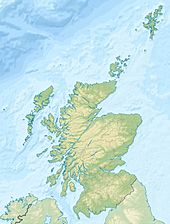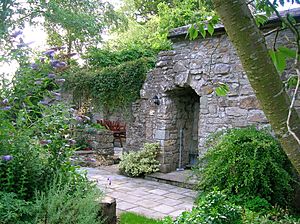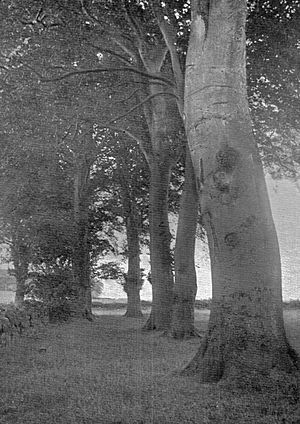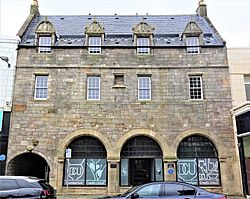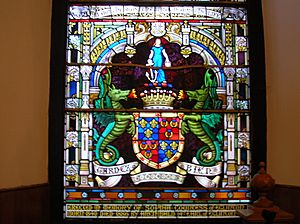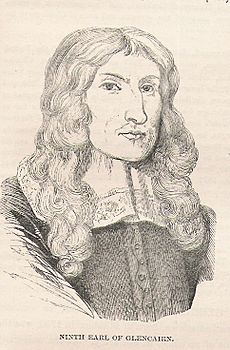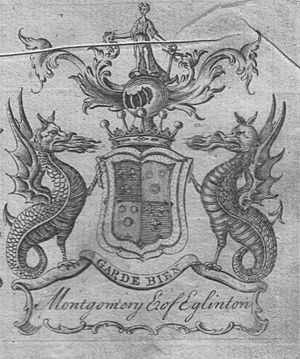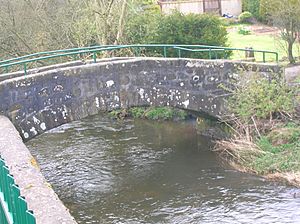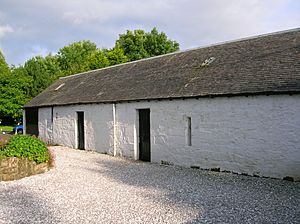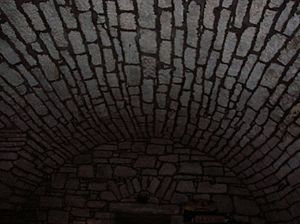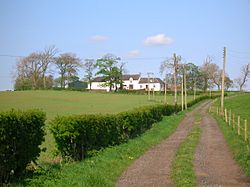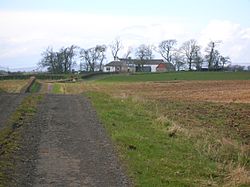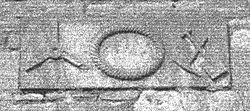Kilmaurs Place facts for kids
Quick facts for kids Kilmaurs Place |
|
|---|---|
| Kilmaurs, North Ayrshire, Scotland UK |
|
| Coordinates | 55°38′16″N 4°31′25″W / 55.637694°N 4.523611°W |
| Type | A castle with a later laird's house |
| Site information | |
| Owner | Private |
| Controlled by | Earls of Glencairn |
| Open to the public |
No |
| Condition | Partly ruined and robbed |
| Site history | |
| Built | 14th century |
| Built by | Clan Cunningham |
| In use | 14th to present |
| Materials | Stone |
Kilmaurs Place, also known as The Place or Kilmaurs House, is an old mansion in Kilmaurs, Scotland. It includes parts of the ruined Kilmaurs Tower. The house sits on a hill overlooking the Carmel Water, giving it a great view.
It was once the main home of the Cunningham Earls of Glencairn. However, after 1484, they moved their main residence to Finlaystone. Kilmaurs Place is different from Kilmaurs Castle, which was located near Jocksthorn Farm.
Contents
Exploring the History of Kilmaurs Place
How Kilmaurs Place Began
The ruined parts you see today are from Kilmaurs Tower. This tower replaced an even older Kilmaurs Castle near Jocksthorn. Kilmaurs Tower was described as "an ancient, strong building" with a large park called Carmell wod.
Kilmaurs Place, the house we see now, was started by William Cunningham, 9th Earl of Glencairn (1610–64). He was the Lord Chancellor of Scotland from 1660 to 1664. He planned a very big and impressive building. However, he ran into money problems and passed away unexpectedly. This meant the original design was never finished. Today's building is what remains of that unfinished mansion.
The Statistical Account from the late 1700s mentioned that the Chancellor had started a huge building. But because of money troubles, he had to stop the project.
Experts believe Kilmaurs Place is a 17th-century mansion. It was built next to the east wall of the older Kilmaurs Tower. The construction on the new building stopped when the 9th Earl of Glencairn died.
| What's in a Name? |
| The name Carmel comes from 'Caremuall'. It is thought to mean 'fort on the hill' in Gaelic. |
In 1875, Adamson called the building 'My Lord's Place'. He noted that while the mansion house was in good shape, nearby stone blocks were very old. These blocks were actually parts of the grand structure that the Lord Chancellor had started building. Hume described The Place as being built around 1620. It had a T-shape and a spiral staircase. He believed the ruins were from the older tower.
Many historians agree that the ruins are from the old castle or tower. The main building is a mansion from around 1630. It shares some design features with the Fenwick Parish Church built in 1643.
Kilmaurs House and the Cunninghams of Robertland
In 1537, David Cuninghame of Robertland had a dispute with William, Lord Semple. Lord Semple was accused of taking items from David Cunninghame's "place, houssis and Kirkland of Kilmawris" in 1520. This included jewels, silver, gold coins, and other valuables. Twelve "gret silver sponis" (large silver spoons) were specifically mentioned.
In 1616, William, Lord Kilmaurs, gave the "manorplace of Kilmaurs" to David Cunningham of Robertland. Later, William Logan, who managed the Robertland Estate, lived at Kilmaurs Place. He wrote many letters from here between 1774 and 1784.
Kilmaurs House and the Montgomerie Family
Around 1720, Alexander, 9th Earl of Eglinton, bought 'The Place' and the rest of the Barony of Kilmaurs. He bought it from William Cunningham, 12th Earl of Glencairn. At this time, the house was called 'Kilmaurs House'.
Susanna Montgomery, Lady Eglinton, who was the dowager Countess of Eglinton, lived here for a while. A dowager is a widow who holds a title from her deceased husband. It was common for dowagers to move out of the main family home. Susanna first moved to Kilmaurs Place. After 1762, she moved to Auchans House near Dundonald, South Ayrshire. Letters from 1751 to 1762 show her writing from Kilmaurs. After 1765, her letters were written from Auchans House.
In 1751, Susanna wrote to her daughter, Lady Mary Murray, about Kilmaurs House. She described it as "a very odd one at present." She mentioned that it "held out neither wind nor weet" (it wasn't protected from wind or rain). She even fell through the floor twice! She had carpenters and masons working on it to make it better. She noted that it had "plenty of fine coall" and was pretty for an inland place, but being near a village had its downsides.
In 1762, she wrote that her son had given her Auchans House. She planned to repair it. After her son Alexander passed away in 1769, she moved permanently to Auchans when her second son married in 1772.
By 1820, Lady Montgomery Burgess owned the property. She was the granddaughter of the 9th Earl of Eglinton.
William Logan, the Robertland Estate Factor, lived at Kilmaurs Place. He employed a man named Robert Burnes, who was the uncle of the famous poet Robert Burns. Logan wrote letters from Kilmaurs Place between 1774 and 1784. Logan later lived at Thorntoun House. In 1793, Captain Ralston lived at Kilmaurs House.
In 1786, the 14th Earl of Glencairn sold The Place to the Marchioness of Titchfield.
Later, The Place and Morton Park were given to the people of Kilmaurs. This gift came from Lady Sophia Montgomerie, daughter of the 14th Earl of Eglinton. She passed away in 1942. The park was named after the Morton family in 1921. The house was later sold and became privately owned.
The Maak's Well
The Monk's or Mack's Well is a spring whose water flows into the Carmel River below Kilmaurs Place. A story says that long ago, the local lord tried to stop people from using the well. It dried up until he changed his mind. Since then, it has flowed continuously. Stepping stones once crossed the river, but a footbridge was built in 1824. Locals pronounce it closer to 'Mank's well.'
One summer, the Carmel River almost dried up. But the Maak's well kept flowing. Local farmers brought carts to collect water in barrels. In 2013, the well no longer flows into the Carmel Water because new railings were put in by the riverbank.
What Does Kilmaurs Mean?
Today, people believe the name Kilmaurs comes from the Gaelic words Cil Mor Ais. This means 'Hill of the Great Cairn'. It's not thought to be named after Saint Maurs.
Kilmaurs as the Clan Cunningham Home
In the late 14th century, Sir William Cunningham of Kilmaurs married Margaret Denniston. She brought the lands of Glencairn and Finlaystone into the family. After this, Kilmaurs became less important as the family's main home. Finlaystone was preferred. Sir William's grandson, Alexander Cunningham, became the 1st Earl of Glencairn in 1488. The Cunningham chiefs had less connection with Kilmaurs after 1484, when Finlaystone became their main family seat.
Margaret Denniston was the only heir to Sir Robert Denniston in 1405. Her dowry included several baronies, including Finlaystone. In 1545, Kerelaw Castle was the summer home of the Earl of Glencairn, and Finlaystone was their winter home.
William Cunningham, 9th Earl of Glencairn
William Cunningham, 9th Earl of Glencairn first supported King Charles I. Because of this, he lost his title for a time. But he soon realized Scotland might get caught in the fight between Charles and Parliament. So, his support for the king lessened. William's title was given back to him. After Charles I was executed, William fought against General Monck when Oliver Cromwell invaded Scotland.
After some challenges, he had to surrender. He returned home but was put in prison because he was suspected of plotting. After King Charles II returned to power, William was rewarded. He became a Privy Councilor. A few years later, in 1660, he became Lord Chancellor. This was when he started to make Kilmaurs Place bigger. Later, political problems reduced his power, and he died feeling disappointed. A large room at Kilmaurs Place is called the 'Chancellor's Hall or Study.'
His second wife was Lady Margaret Montgomerie. She was the daughter of the 6th Earl of Eglinton.
The Ralston Family Connection
Captain William Ralston worked for the Earl of Eglinton. He lived at Kilmaurs Place in 1793. The Statistical Account of Scotland from the late 1700s praised his business skills. It said he managed Lord Eglinton's affairs very well. He also managed his own large farm.
William Ralston married Elizabeth Dun in 1783. They had several children. Alexander McDougal Ralston, who died in 1862 at age 64, is buried in Dreghorn Parish Church cemetery.
Important Dates for Kilmaurs Place
Here are some key dates related to Kilmaurs Place and the older Kilmaurs Castle:
- 1484 - The Earls of Glencairn moved their main family home to Finlaystone Castle. They had inherited it in 1405.
- 1520 - David Cunninghame of Robertland was recorded as owning the "place, houssis and Kirklands of Kilmawris."
- 1608 - Kilmaurs Tower was shown on Timothy Pont's map. Kilmaurs Place was not yet built.
- 1616 - William Cunningham gave the 'manor place' to David Cunningham of Robertland.
- 1623 - The Glencairn Greit House was built in Dumbarton. It was the Earls of Glencairn's townhouse.
- 1660 to 1664 - William Cunningham, the 9th Earl, started building a large new structure at Kilmaurs. He later stopped the work.
- 1685 - The first mention of "The Place" was recorded.
- 1720 - The Earl of Eglinton bought Kilmaurs Place from William Cunningham.
- 1751 - 1762 - Susanna, Dowager Countess of Eglinton, lived at Kilmaurs Place.
- 1774 - 1784 - William Logan, who managed the Robertland Estate, lived at Kilmaurs Place.
- 1786 - The 14th Earl of Eglinton sold Kilmaurs Place to the Marchioness of Titchfield.
- 1793 - Captain Ralston, who worked for the Earl of Eglinton, lived at Kilmaurs Place.
- 1820 - Lady Montgomery Burgess, a great-granddaughter of the 9th Earl of Eglinton, lived at Kilmaurs Place.
- 1935 - The house was being used as a farmhouse.
- 1956 - The house was still in use as a farmhouse.
What Kilmaurs Place Looks Like
In old Scots language, a 'Place' meant a large mansion house owned by a landowner. It often referred to a building with a central courtyard. This suggests Kilmaurs Place was meant to be a bigger building with a courtyard. Some surviving walls and features support this idea.
The building has a main section that runs roughly east to west. There's a stair-wing sticking out from the middle of the west wall. It has two stories and an attic. Other buildings around it were once farm outbuildings.
In 1956, Kilmaurs Place was described as restored and used as a farmhouse. It was listed as a Category B historic building in 1971.
The house has a 'T' shape and was built around 1620. The 'ruins' seem to be the unfinished lower floor of a 16th-century section. The main house itself doesn't have vaulted ceilings. However, the 'ruins' have a vaulted chamber with a slate roof. This room is still used by the current owners and is known as the Chancellor's Study. In the early 1800s, this room was used as a milk house. The main house has a beautiful 16th-century fireplace.
The original entrance was at the staircase part. You can still see the old door and a coat of arms above it. The windows and floor levels inside the building have been changed a lot over time. Some experts think Kilmaurs Place might have been built on top of an even older castle. The house was built at the very end of a time when homes needed to be defensive.
In 1912, you could still see the remains of an old avenue of trees leading to the house. A few of these beech trees were still there in 1945. The entrance from Mill Vennel, with a bridge over the Carmel Water, was likely made when the main entrance was changed.
Old maps from 1788-91 show an entrance leading straight to The Place from near the bridge on the Kilmaurs Road. The maps also show formal gardens laid out in squares. These gardens were on the church side of the house. In 1945, the vaulted ruins were used to store farm tools.
The bridge over the Carmel at Fenwick Road was built to provide access when the main entrance was moved to the north side of the house.
Kilmaurs Tower Ruins and Place in 1912
Local stories say that John Stewart, a reputed warlock (someone thought to have magical powers), often met with fairies on Kilmaurs Hill.
Later owners of Kilmaurs Place included the Tannock family, who were threshing contractors, and Mr. Eric Anderson, who owned a DIY shop in Kilmaurs Village.
Kilmaurs Place and Surroundings in 2008
The Gardens of Kilmaurs Place in 2009
Kilmaurs Castle
The Statistical Account from the late 1700s mentioned that the Earl of Glencairn's family once lived in Kilmaurs. It said that "some small ruins" of their old house still remained on a farm called Jock's-thorn. This farm was near the road from Stewarton to Kilmarnock.
In 1875, Adamson wrote that the old castle was near Jock's Thorn farm. Several older people from Kilmaurs remembered playing among the ruined stones of this old Cunningham castle. People using metal detectors have found medieval coins in this area. Old maps from the 1800s also mark the supposed site of Kilmaurs Castle near Jocksthorn.
Dobie wrote in 1874 that the old baronial home was about a mile southeast of Kilmaurs. Ruins could still be seen at Jock's Thorn farm. He thought this might have been the original home of the ancient Cunningham family.
Experts like Davis note that the local farmer has found pottery and stones when plowing a raised area near Jock's Thorn farm. This suggests an old building was there.
A charter from 1498 mentions "the Castle and Fortalice of the Barony and lands of Kilmaweris." This suggests there were two defensive structures. Kilmaurs Place was likely the main baronial residence. Jock's Thorn was probably a "fortalice," which was a smaller fort. Fortalices were often used to protect common people, not just the laird. For example, in Stewarton, Corsehill Castle was the main home, and Templehouse was a fortalice for protecting tenants.
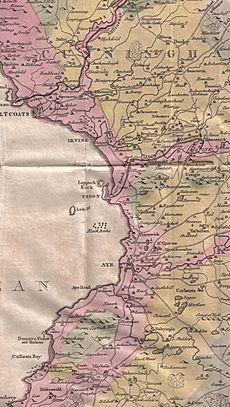
The Barony of Kilmaurs
The Barony of Kilmaurs was a large area of land. It included places like Buston (now Buiston), Fleuris (now Floors), Lambroughton, Whyrrig (now Wheatrig), and Southwick (now South Hook). South Hook is near Knockentiber and was part of the Lambroughton area within the barony.
Kilmaurs Barony Mill
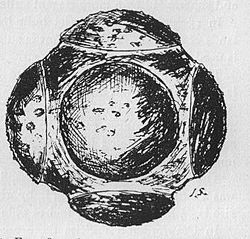
The mill was taken down in the late 1980s. It was built by the Earl of Eglinton in the early 1800s on an older mill site. It was a large, three-story building with a kiln for drying grain. The kiln was last used in 1946. It had a firebox that heated a drying floor made of cast-iron tiles. The floor collapsed in 1964 while storing barley, and the miller had to be rescued.
The mill had an internal waterwheel and worked until 1966. In 1985, it was thought to be one of the last complete examples of a large Scottish estate mill.
In 1870, James Wyllie, the miller, and his wife lived at 'The Place'. In 1877, John Mackie became the miller and lived there with his wife.
Over the 20th century, the mill used different power sources: a turbine, an oil engine, a steam engine, and finally an electric engine. The waterwheel was no longer used.
The mill had five pairs of millstones. In the 1800s, it ground oats. Later, it crushed peas and beans for animal feed.
Every barony had a thirled mill. This meant that the tenant farmers had to use the laird's mill. The Kilmaurs Mill on the Carmel Water dates back to at least the early 1600s. An interesting feature of this old mill was a carved stone. It showed a millstone part, a rope, a tool for shaping millstones, and a grain shovel. This stone is still built into a wall at the old mill site.
Local names like 'Ladeside' remind us of the mill. The old lade (a channel for water) took water from the Carmel Water. The remains of the old mill pond dam are still visible today.
See also
- Kilmaurs Castle
- Lands of Tour and Kirkland


